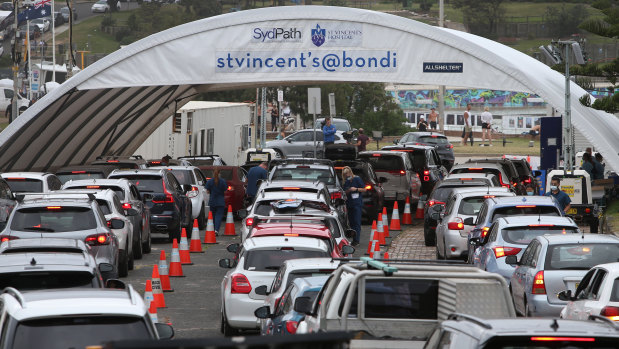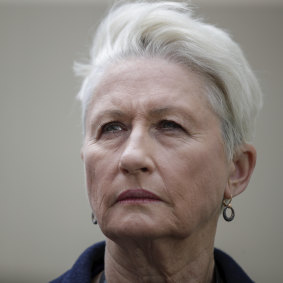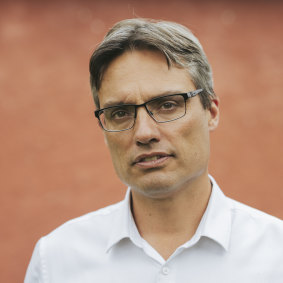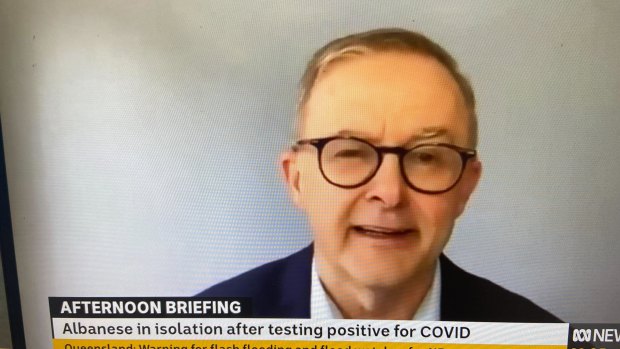This was published 2 years ago
Who’s living in fantasy land? As the election recedes, the politics of COVID re-emerges
Something happened while we were all distracted by the election. Slowly, maybe imperceptibly, the number of Australians dying of COVID-19 has ticked upwards. On April 10, the day Scott Morrison called the poll for May 21, the seven-day rolling average of deaths was 25. It has now doubled.
For some in the medical community this is cause for serious alarm. Not only is COVID on the rise, but we seem less bothered by it. The political class is over it; the pandemic barely rated a mention during the campaign, the media has lost interest and most people seem to have moved on.

Lines at the Bondi COVID testing centre in December. Apart from Anthony Albanese’s week in COVID-19 isolation, the pandemic was not a major presence on the campaign trail.Credit: Getty Images
Other experts are less worried. This was always going to happen, they say, and our high level of vaccination is keeping serious illness to a minimum. The public has no appetite for restrictions, while numbers ought to start falling soon anyway. They also accuse hardline COVID warriors of stoking unnecessary fear using similar arguments to anti-vaxxers.
General practitioner Kerryn Phelps, a former independent MP and a former head of the Australian Medical Association, is among those calling for N95 masks to be mandatory in public indoor spaces, and a return to longer and stricter isolation rules.
“COVID has been hiding in plain sight throughout the whole election campaign,” Phelps says. “There’s an enormous amount of disquiet about it in the community and there’s a great deal of misinformation which I find very concerning. We have to work out ways of bringing down those rates of transmission.”
The divide in the medical community mirrors the divide in broader society. Some of us have co-morbidities, most of us don’t. Some people still wear masks, others don’t. Some are still taking precautions against catching COVID; others have already had it and are living life as normal.
Phelps is adamant: “What we’re living at the moment people think is a normal existence, but it’s not. It’s an illusion.”
Since the start of the pandemic, 8374 people have died with COVID in Australia; 347 in the past week. NSW and Victoria are each recording about 10,000 new cases a day, though NSW has trended down since early April; most of those cases are now reported from DIY rapid tests.
Phelps says the real caseload is much higher because many people are not testing or not reporting the results of their tests. Critics agree, but say that simply shows the real death rate is lower than the figures suggest.

Demanding COVID restrictions return: Dr Kerryn Phelps.Credit: Alex Ellinghausen
Phelps and other prominent health experts are frustrated by many aspects of the current COVID discourse; people’s blasé attitude to the virus, their apathy about reinfection or long COVID and - most of all - the way the pandemic is often talked about in the past tense.
“One thing that has been enormously frustrating is the subtle use of language to imply that the pandemic is over. We’re still in the middle of it,” says Phelps.
“There’s no question there was message massaging from Scott Morrison and his then government ministers. He was saying things like, ‘We have led the country out of the pandemic’. That was just plain and simply wrong. The media were reporting what they were saying, as they do, but without critical analysis of the facts.”
Phelps concedes that for the majority of people who contract COVID-19, it will be a mild illness - perhaps even similar to the common cold - which probably explains their lack of concern about contracting it again.
But that’s a mistake, she says. “What about next time? They’re still susceptible to the next variant that comes along. Some people get a lot sicker the second time around or the third time around.”
This claim is highly contentious. UNSW Kirby Institute professor Greg Dore says there is now good data from the United Kingdom that shows reinfection with Omicron is rare. While some individuals may get sicker on reinfection, “the likelihood is that it will be less severe”.
Dore believes case numbers will decline in coming weeks. He has some sympathy for those who want stronger measures to reduce transmission, but he does not believe they will work. N95 masks might be appropriate for the vulnerable, but most people will not truck them after more than two years of disruption.
“I know people are frustrated and they want to do something, but bringing in mask mandates is not going to turn the epidemic around. That’s where the discussion gets stuck,” Dore says.
“Even the people more on the left end of the COVID spectrum, they are realistic in saying we can’t go back to lockdowns. They’re clutching at straws saying: what can we do?”
While there has always been a range of views in the medical fraternity about how to handle COVID, some experts feel the more alarmist commentators among them are beginning to deploy the same kinds of arguments used by anti-vaxxers last year.
Nick Coatsworth, the former deputy chief medical officer who appeared in government vaccine ads and was a major figure in the earlier stages of the pandemic, says there are three major parallels - the spectre of the “unknowns” of long-COVID, the notion that the real statistics are being covered up, and the use of highly emotive but false analogies.
“The sequences of logic that they’re using are almost identical,” Coatsworth says. “They’re reverse engineering the arguments from their ideological position, which is why the arguments appear so similar.”
Though long-COVID is real, Coatsworth says it has been misused by hard line COVID-zero advocates in the same way anti-vaxxers said they won’t take the vaccine because they don’t know its long-term effects. COVID-zero advocates say we don’t know enough about long-COVID; therefore we should err on the side of caution.
Just as anti-vaxxers suggested the public was not being given all the data about deaths and side effects from the vaccines, many who want stronger action on COVID claim the government and media are covering up the true extent of the virus in the community.
Coatsworth acknowledges Australia is currently experiencing a relatively high number of COVID deaths. Some people have called it “a plane crash a week”. But he takes issue with that analogy, pointing out COVID deaths are very much skewed to the elderly.
“A plane crash has anywhere between babies through to people at the end of their lives and everything in between,” Coatsworth says. “So it’s not a reasonable analogy to draw when we’re talking about largely the very frail elderly, who are very likely to succumb to infection whether there’s a pandemic or not.”
Dore, the UNSW epidemiologist, makes the same point. “The median age of death is in the 80s. There are very few people younger than their 70s dying - very, very few.”

Former deputy chief medical officer Nick Coatsworth says public interest in the pandemic has waned.Credit: Jamila Todera
Phelps finds such observations distasteful, as she does the distinction between people dying of COVID or with COVID, which implies other factors were at play. “Ninety per cent of people are dying from the disease. They are losing years of life,” she says.
Statistics on excess mortality show this is true; the Herald and The Age reported that in January there was a 22.1 per cent increase in overall deaths compared with the January average.
Phelps rejects comparisons to the language or arguments used by anti-vaxxers. Some of the people making that case were demonstrably wrong throughout the pandemic, she says.
“They were wrong about airborne spread, they were wrong about the need to wear masks. I think we need to go back to that precautionary principle because we now know quite a lot more about things like long-COVID and the death rates.”
But Phelps does believe there are deliberate efforts afoot to “fool people into thinking COVID is over”. On Monday, she retweeted a tweet saying the media and government must drop the “quite frankly bizarre denial the pandemic is over and COVID doesn’t exist”.
Phelps also retweeted someone who said he “won’t stay in a hotel with corridors anymore” as they are “absolutely lethal”. “Hotels with sealed windows, corridors and no balconies may well become obsolete,” Phelps added.
During the campaign, Anthony Albanese said if he won the election he would order an urgent briefing on COVID-19 and promised a “step up” in the country’s national strategy. But it was not clear that would involve much more than an attempt to accelerate booster uptake. The states - all Labor except for NSW and Tasmania - have shown no desire to reintroduce COVID measures.
Around the world there is a reluctance to go back in time and start resuscitating the restrictions of the past, despite high case numbers. The United Kingdom removed all COVID-19 rules in February, including the requirement for COVID-positive people to isolate, which Australia seems unlikely to scrap in the near future.

Anthony Albanese during a TV interview while isolating at home with COVID on April 22.
And New York City mayor Eric Adams last week resisted pressure to reintroduce a mask mandate. “Variants are going to come,” he was quoted as saying. “If every variant that comes, we move into shutdown thoughts, we move into panicking, we’re not going to function as a city.”
Dore says there are three things Australia could do that don’t involve going backwards: ensure vaccine coverage, including fourth doses, is as high as possible; revisit the eligibility criteria for antiviral treatments to approve greater access; and take a closer look at who is dying and why.
“It’s not as if they’re hiding it - not at all,” he says. “But there’s more that can be done.”
Dore points out that with no longer public health problem have we had anywhere near the level of publicly available data as we have with COVID-19. The state health departments still release the number of cases and deaths daily, as does the federal government. The tree is still falling in the forest, even if fewer people are interested in hearing it.
Speaking to 3AW radio’s Neil Mitchell last week, Burnet Institute microbiologist Brendan Crabb expressed astonishment that COVID-19 had fallen out of the public mindset despite the deaths.
“There’s a bit of a mass brain fade, a national brain fade that’s happened right from the beginning of Omicron,” he said. “We’ve been ‘living with COVID’, euphemistically, meaning do nothing about it. We are living in a kind of fantasy land.”
But Coatsworth says it’s not fantasy - it’s reality. “Attention will naturally wane, that’s not a new phenomenon,” he says. “That’s been in pandemic plans ever since we’ve had pandemic plans.
“One of the reasons long-term restrictions don’t work is that eventually society does move on. We have got to acknowledge that people will make decisions based on personal risk. People are moving on when the personal risk is low. There’s nothing politicians or healthcare providers or the media can do about that.”